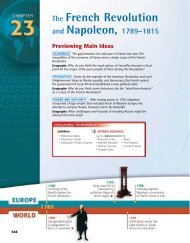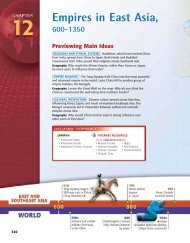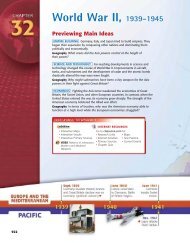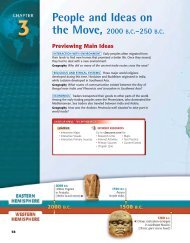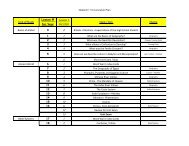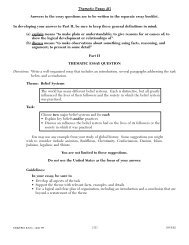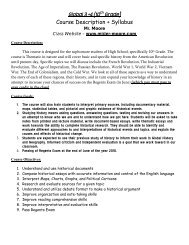Chapter 34 - First
Chapter 34 - First
Chapter 34 - First
Create successful ePaper yourself
Turn your PDF publications into a flip-book with our unique Google optimized e-Paper software.
Analyzing Causes<br />
What was the<br />
cause of the conflict<br />
between India and<br />
Pakistan over<br />
Kashmir?<br />
During the summer of 1947, 10 million people were on the<br />
move in the Indian subcontinent. As people scrambled to relocate,<br />
violence among the different religious groups erupted.<br />
Muslims killed Sikhs who were moving into India. Hindus<br />
and Sikhs killed Muslims who were headed into Pakistan.<br />
The following passage is representative of the experiences of<br />
people in both the Hindu and Muslim communities:<br />
PRIMARY SOURCE<br />
All passengers were forced into compartments like sheep and<br />
goats. Because of which the heat and suffocating atmosphere<br />
was intensified and it was very hard to breathe. In the ladies<br />
compartment women and children were in a terrible condition.<br />
Women tried in vain to calm down and comfort their children.<br />
If you looked out the window you could see dead bodies lying<br />
in the distance. At many places you could see corpses piled on<br />
top of each other and no one seemed to have any concern. . . .<br />
These were the scenes that made your heart bleed and<br />
everybody loudly repented their sins and recited verses asking<br />
God’s forgiveness. Every moment seemed to be the most<br />
terrifying and agonizing.<br />
ZAHIDA AMJAD ALI, quoted in Freedom, Trauma, Continuities<br />
In all, an estimated 1 million died. “What is there to celebrate?”<br />
Gandhi mourned. “I see nothing but rivers of<br />
blood.” Gandhi personally went to the Indian capital of<br />
Delhi to plead for fair treatment of Muslim refugees. While<br />
there, he himself became a victim of the nation’s violence.<br />
A Hindu extremist who thought Gandhi too protective of<br />
Muslims shot and killed him on January 30, 1948.<br />
The Battle for Kashmir As if partition itself didn’t result<br />
in enough bloodshed between India’s Muslims and Hindus,<br />
the two groups quickly squared off over the small region of<br />
Kashmir. Kashmir lay at the northern point of India next to<br />
Pakistan. Although its ruler was Hindu, Kashmir had a<br />
majority Muslim population. Shortly after independence,<br />
India and Pakistan began battling each other for control of the region. The fighting<br />
continued until the United Nations arranged a cease-fire in 1949. The cease-fire<br />
left a third of Kashmir under Pakistani control and the rest under Indian control.<br />
The two countries continue to fight over the region today.<br />
Modern India<br />
With the granting of its independence on August 15, 1947, India became the<br />
world’s largest democracy. As the long-awaited hour of India’s freedom<br />
approached, Jawaharlal Nehru, the independent nation’s first prime minister,<br />
addressed the country’s political leaders:<br />
PRIMARY SOURCE<br />
Long years ago, we made a tryst [appointment] with destiny, and now the time comes<br />
when we shall redeem our pledge, not wholly or in full measure, but very substantially.<br />
At the stroke of the midnight hour, when the world sleeps, India will wake to life and<br />
freedom.<br />
JAWAHARLAL NEHRU, speech before the Constituent Assembly, August 14, 1947<br />
The Coldest War<br />
No part of Kashmir is beyond a fight<br />
for India and Pakistan—including the<br />
giant Siachen glacier high above the<br />
region. The dividing line established<br />
by the 1949 cease-fire did not extend<br />
to the glacier because officials figured<br />
neither side would try to occupy such<br />
a barren and frigid strip of land.<br />
They figured wrong. In 1984, both<br />
sides sent troops to take the glacier,<br />
and they have been dug in ever<br />
since. At altitudes nearing 21,000<br />
feet, Indian and Pakistani soldiers<br />
shoot at each other from trenches in<br />
temperatures that reach 70 degrees<br />
below zero. This bitterly cold war was<br />
interrupted in 2003 when Pakistan<br />
and India declared a ceasefire.<br />
The Colonies Become New Nations 999







